Abstract
Binary or dichotomous thinking may lead to aggression throughout people’s lifespan; additionally, relationships are likely to be affected by types of aggression (i.e. physical aggression, verbal aggression, anger, and hostility) as well as gender and age. Using large-scale data (N = 2,315), the current study tested if age or gender moderated dichotomous thinking’s correlation with four different types of aggression. Participants (Mage = 36.1, SD = 16.2, range = 18–69) completed the Dichotomous Thinking Inventory and the Buss-Perry Aggression Questionnaire. Dichotomous thinking differentially affected aggression depending on participants’ age: dichotomous thinking and aggression were more strongly correlated in younger participants. Individuals’ tendency to think dichotomously appeared relatively stable; however, age appeared to moderate dichotomous thinking’s effects.
Public Interest Statement
Dichotomous or binary thoughts (i.e. “black or white,” “good or bad,” “positive or negative,” and “all or nothing”) is one of the fundamental thinking styles of human beings. The benefit of this thinking style is linked to a quick decision-making. However, it also connects to negative psychological traits such as aggression, cognitive biases, and personality disorders. This study analyzed the moderation effects of age and gender on the relationships between binary thinking and aggression in a large sample with a wide age range. Age and gender each independently moderated the correlations between several types of binary thinking and aggression; additionally, age and gender interactively moderated such correlations. The results suggest that younger people who think dichotomously tend to feel anger and hostility more than older people.
Competing Interests
The authors declare no competing interest.
1. Introduction
Aggression is a serious problem and a particular social concern among adolescents (Herrenkohl, Catalano, Hemphill, & Toumbourou, Citation2009). Aggression has been defined as “behavior directed toward another individual carried out with the proximate (immediate) intent to cause harm” (Anderson & Huesmann, Citation2003, p. 298). However, aggression does not exclusively mean unipolar behavior, and may contain broader categories and dimensions of behavior, intent, and affect that is relevant to aggression. Triggers for aggression include environmental cues, biological urges, social-cultural norms, emotions (e.g. fear, anger), impulsivity, attachment style, self-esteem, problem-solving skills, ruminative thought, and cognitive biases (Cummings-Robeau, Lopez, & Rice, Citation2009; McMurran, Blair, & Egan, Citation2002; Nagtegaal & Rassin, Citation2004; Vierikko, Pulkkinen, Kaprio, & Rose, Citation2006; Voulgaridou & Kokkinos, Citation2015).
Research has frequently used social-cognitive information processing theory (SCIP) to explain aggression’s mechanism (Anderson & Huesmann, Citation2003; Boxer & Dubow, Citation2002; Crick & Dodge, Citation1994; Pakaslahti, Citation2000). The SCIP proposes the following macro-processes such as environmental factors in problem-solving that may lead to aggression: (1) encoding and interpreting environmental cues, (2) generating and selecting goals, behaviors, or scripts to guide behavior, (3) evaluating the selected script for appropriateness on several dimensions, and (4) behavioral enactment followed by interpretation of others’ responses. In these processes, paranoid thoughts and some cognitive biases are linked to aggression (Tone & Davis, Citation2012).
Dichotomous or binary thinking is understudied but likely to affect all of the processes proposed by SCIP; it is the propensity to think in terms of binary oppositions (i.e. “black or white,” “good or bad,” “positive or negative,” “all or nothing”; Oshio, Citation2009). Dichotomous thinking facilitates quick decision-making and categorization of information, and people commonly think in dichotomous terms; however, dichotomous thinking may promote detrimental outcomes including adjustment problems (Campbell, Spieker, Burchinal, Poe, & The NICHD early child care research network, Citation2006) and suicide attempts (Neuringer, Citation1961), and may be a cognitive problem in people with borderline personality disorder (Napolitano & McKey, Citation2007). Additionally, dichotomous thinking is associated with a wide range of personality disorders (Oshio, Citation2012), and particularly with Cluster B (including antisocial, borderline, histrionic, and narcissistic personality disorders; Oshio, Citation2009, Citation2012). Cluster B personality disorders include problems with emotional regulation and impulse control, and are linked to aggression, anger, and depression (American Psychiatric Association, Citation2013). Dichotomous thinking’s relationship with such problems may reflect a tendency to promote cognitive distortions and dysfunctional beliefs; accordingly, cognitive therapy aims to help dichotomous-thinking patients resolve such distortions and beliefs (Beck, Freeman, & Davis, Citation2004).
There are a few possibilities of the linkage between dichotomous thinking and aggression. First, dichotomous thinking may lead to extreme emotional reactions when activated, impeding emotional regulation processes and leading to problematic behavior such as aggression (Gross, Citation2002). Second, personality develops and constructs person’s knowledge structures that influence an evaluation of the meaning of the negative affect and the aversive situations (Anderson & Huesmann, Citation2003). And dichotomous thinking is closely associated with the specific personality traits that link to aggression; Cluster B personality disorders (Oshio, Citation2009, Citation2012), psychological entitlement (Shimotsukasa & Oshio, Citation2016), and Dark Triad (Oshio, Shimotsukasa, & Mieda, Citation2016). Third, dichotomous information-processing may lead to an impulsive and thoughtless emotion such as anger. These possibilities imply that dichotomous thinking has an effect on not only aggressive behavior but personality and cognitive aspects of aggression. However, there has been a lack of evidence of the relationships between dichotomous thinking and aggression.
Age and gender may critically moderate the relationship between dichotomous thinking and aggression. Age and gender each directly affect aggression; additionally, their effects interact (Campano & Munakata, Citation2004; Lee, Baillargeon, Vermunt, Wu, & Tremblay, Citation2007; Scheithauer, Haag, Mahlke, & Lttel, Citation2008). Further, the moderation of aggression by age and gender varies depending on aggression type (Tapper & Boulton, Citation2000; Toldos, Citation2005; Tsorbatzoudis, Travlos, & Rodafinos, Citation2013). Studies reporting mean-level age change of big five personality traits (Kawamoto et al., Citation2015; Soto, John, Gosling, & Potter, Citation2011; Srivastava, John, Gosling, & Potter, Citation2003) suggested that agreeableness, which represents low aggression, ascends with age in adulthood. Impulsivity and sensation-seeking, which also closely link to aggression, have been suggested to descend with age from adolescence to adults (Steinberg et al., Citation2008). These findings suggest that older people would be less aggressive than younger people, and the reason behind this is that the cognitive process of aggression may change throughout the adult development.
The Buss Perry Aggression Questionnaire (BAQ) measures four types of aggression using the following subscales: physical aggression, verbal aggression, anger, and hostility (Buss & Perry, Citation1992). Physical and verbal aggression involve harming or hurting others; this represents the instrumental and behavioral aspects of aggression. Anger involves physiological arousal and preparation for aggression; this represents emotional or affective aspects of aggression. Hostility involves feelings of ill will and injustice; this represents cognitive aspect of aggression. The BAQ is among the most widely used scales that measure trait aggression; extensive research has examined the relationships between scores on the BAQ’s subscales and a range of variables, such as aggressive acts (Archer & Webb, Citation2006), bullying (Palmer & Thakordas, Citation2005), personality traits, and alcohol consumption (Tremblay & Ewart, Citation2005). Nonetheless, little research has examined the BAQ subscales’ relationship with dichotomous thinking. Similarly, although several studies have examined age and gender differences in aggression, most have examined a limited age range (e.g. children or adolescents; Lee et al., Citation2007; Tapper & Boulton, Citation2000; Toldos, Citation2005). Aggression remains prevalent in adulthood (Marsland, Prather, Petersen, Cohen, & Manuck, Citation2008; Murray-Close, Ostrov, Nelson, Crick, & Coccaro, Citation2010); therefore, research examining a broader age is required.
In this context, the present study examined the moderation effects of age and gender on the relationships between dichotomous thinking and aggression in a sample with a wide range of age. We hypothesized that there are positive relationships between dichotomous thinking and aggression, and these relationships are moderated by age and gender.
2. Method
2.1. Participants and procedure
In total, 2,315 Japanese people participated (1,128 females and 1,187 males); their average age was 36.1 years (SD = 16.2; range: 18–69). Age groups were as follows: 18–19 years (n = 474; 208 females), 20–29 years (n = 628; 314 females), 30–39 years (n = 304; 152 females), 40–49 (n = 304; 152 females), 50–59 (n = 303; 152 females), and 60–69 (n = 302; 151 females). Participants were recruited from approximately 1.7 million members of comprehensive internet survey panels through Cross Marketing, Inc. (a major Japanese internet survey company), and received a small monetary compensation. We provided the participants with a privacy policy; participants agreed that their answers would be used in anonymous analysis. Cross Marketing provided the participants’ data-set.
2.2. Measures
2.2.1. Dichotomous thinking
The dichotomous thinking inventory (DTI; Oshio, Citation2009) was used to measure participants’ tendency to think dichotomously. The DTI consists of 15 items contained in three subscales. The DTI’s subscales measure the following factors: Preference for Dichotomy (e.g. “all things work out better when likes and dislikes are clear”), Dichotomous Belief (e.g. “There are only ‘winners’ and ‘losers’ in this world”), and Profit-and-Loss Thinking (e.g. “I want to clearly distinguish what is safe and what is dangerous”). Responses used a 6-point Likert scale (1 = strongly disagree, 6 = strongly agree). In the present study, values of Cronbach’s α ranged from 0.76 (Preference for Dichotomy) to 0.89 (Total DTI score); this indicated good internal consistency.
2.2.2. Aggression
The Buss-Perry Aggression Questionnaire (BAQ; Buss & Perry, Citation1992; translated by Ando et al., Citation1999), one of the most widely used scales that measure trait aggression, was used to measure the following types of aggression: physical aggression (e.g. “If someone hits me, I hit back”), verbal aggression (e.g. “I tell my friends openly when I disagree with them”), anger (e.g. “Sometimes I fly off the handle for no good reason”), and hostility (e.g. “I sometimes feel that people are laughing at me behind my back”). Responses used a 6-point Likert scale (1 = strongly disagree, 6 = strongly agree). This measure’s internal consistency and test-retest stability have been supported (Ando et al., Citation1999). In the present study, values of Cronbach’s α ranged from 0.78 (verbal aggression) to 0.85 (total scale score).
3. Results
3.1. Correlations among variables
Correlation analysis was conducted to test the hypothesized relationship between DTI scores and BAQ scores. Significant correlations were found, ranging from r = 0.17 (dichotomous belief and verbal aggression) to 0.48 (DTI total score and BAQ total score), indicating that dichotomous thinking and aggression are positively associated (Table ). Males’ mean scores were higher than females’ regarding total BAQ score, physical aggression, verbal aggression, and hostility (ts (2,313) = 3.15, 3.81, 2.83, and 2.82, respectively, ps < 0.01, respectively); however, these differences were of small magnitude (Cohen’s d = 0.13, 0.16, 0.12, and 0.12, respectively; Cohen, Citation1977).
Table 1. Correlation coefficients, means, standard deviations, and alpha coefficients among DTI and BAQ scores
3.2. Age and gender moderate dichotomous thinking’s effect on BAQ score
Two-step analyses tested if age or gender moderated dichotomous thinking’s effect on aggression. First, a hierarchical multiple regression analysis predicting total BAQ score was conducted with three predictors (age, gender, and DTI total score). Second, a series of hierarchical multiple regression analyses was conducted to predict scores in each of the four BAQ subscales using five predictors (age, gender, and the three DTI subscales). The continuous predictor variables were centered and a categorical predictor variable was dummy coded (1 = male, 0 = female).
First, age, gender, and total DTI score were entered in Model 1. Subsequently, three first-order interactions were simultaneously entered in Model 2, and a second-order interaction was entered in Model 3. Three first-order interactions were significant (∆R2 = 0.02, p < 0.001), but the second-order interaction was not (∆R2 = 0.00, n.s.; Table ). The final model supported the hypothesis that age and gender interactively moderated DTI score’s ability to predict total BAQ score (β = 0.11, p < 0.001; Figure ). Simple slope analysis indicated that age was negatively associated with BAQ score among only female participants (β = −0.21, p < 0.001), whereas no such association was observed among males (β = 0.01, n.s.). Additionally, age moderated DTI’s ability to predict of total BAQ score (β = −0.05, p < 0.01; Figure ). Simple slope tests indicated that DTI score was more closely associated with BAQ score among younger participants (mean age − 1SD; β = 0.51, p < 0.001) than among older participants (mean age + 1SD; β = 0.40; p < 0.001).
Table 2. Hierarchical regression analysis with BAQ total score as dependent variable
Figure 1. Adjusted predicted values for overall aggression, illustrating the interaction of gender and age.
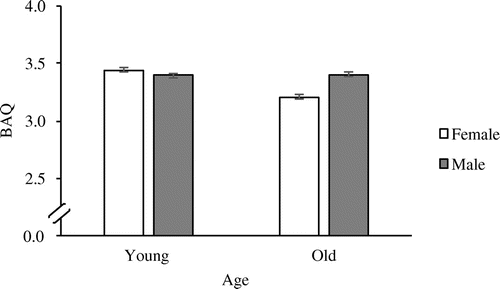
Figure 2. Adjusted predicted values for overall aggression, illustrating the interaction of dichotomous thinking and age.
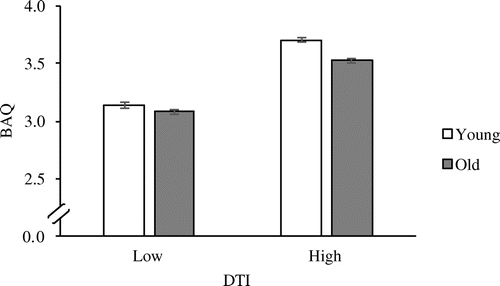
Second, a series of hierarchical multiple regression analyses was conducted to predict scores on each BAQ subscale with five predictors (gender, age, and score on the three DTI subscales), based on age’s significant moderation of DTI’s ability to predict total BAQ score. This analysis examined the moderating effect of age and each dimension of dichotomous thinking on each aspect of aggression. Age, gender, and mean DTI subscale score were entered in Model 1 (Table ). Age and gender were entered as interacting predictor variables in Model 2; age and each mean DTI subscale score were entered as interacting predictor variables in Model 3.
Table 3. Hierarchical regression analysis with four dimensions of BAQ as dependent variables
A hierarchical multiple regression predicting Physical Aggression found that only the interaction between age and gender was significant (β = 0.14, p < 0.001; Figure ). Simple slope tests indicated that age was negatively associated with Physical Aggression among females (β = −0.20, p < 0.001) but positively associated among males (β = 0.19, p < 0.001).
Figure 3. Adjusted predicted values for physical aggression, illustrating the interaction of gender and age.

A hierarchical multiple regression predicting Verbal Aggression found a significant interaction between age and gender (β = 0.08, p < 0.001; Figure ), indicating that age was negatively associated with Verbal Aggression among females (β = −0.06, p < 0.05) and positively associated with Verbal Aggression among males (β = 0.11, p < 0.001). The interaction between age and Dichotomous Belief was marginally significant (β = −0.04, p = 0.07; Figure ), indicating a significant negative association between Dichotomous Belief and Verbal Aggression among only older participants (β = −0.11, p < 0.01).
Figure 4. Adjusted predicted values for verbal aggression, illustrating the interaction of gender and age.
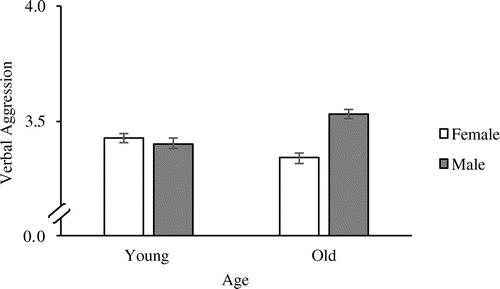
Figure 5. Adjusted predicted values for verbal aggression, illustrating the interaction of dichotomous belief and age.
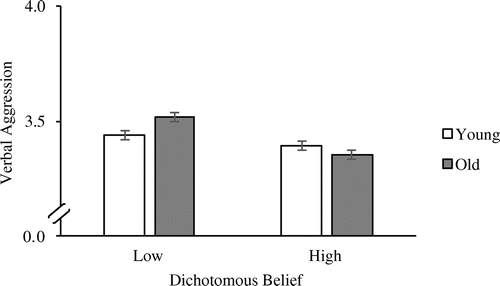
A hierarchical multiple regression analysis predicting Anger found a significant interaction between age and Dichotomous Belief (β = −0.07, p < 0.001; Figure ), indicating that Dichotomous Belief and Anger were more strongly correlated among younger participants (β = 0.25, p < 0.001) than among older participants (β = 0.11, p < 0.01). A significant interaction between age and gender on Aggression was also found (β = 0.04, p < 0.05); However, there were no significant simple slopes in the subsequent analysis.
Figure 6. Adjusted predicted values for anger, illustrating the interaction of dichotomous belief and age.
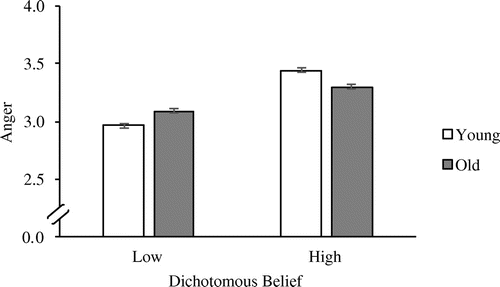
A hierarchical multiple regression analysis predicting Hostility identified significant interactions between age and gender, and between age and Profit-and-loss Thinking (βs = 0.04 and −0.06, ps < 0.05; Figures and , respectively). Simple slope tests indicated that age was more negatively associated with Hostility among females (β = −0.25, p < 0.001) than among males (β = −0.16, p < 0.001), and that Profit-and-loss Thinking was more positively associated with Hostility among younger people (β = 0.22, p < 0.001) than older people (β = 0.10, p < 0.05).
Figure 7. Adjusted predicted values for hostility, illustrating the interaction of gender and age.
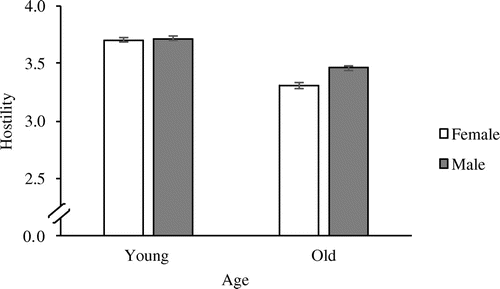
Figure 8. Adjusted predicted values for hostility, illustrating the interaction of profit-and-loss thinking and age.
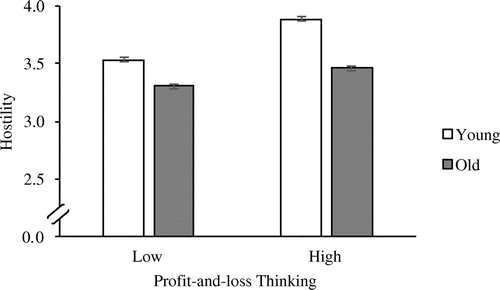
3.3. Correlations between DTI and BAQ scores in each age group
To further clarify age-mediated differences in the relationship between DTI and BAQ scores, correlation coefficients were calculated for each age group (Table ). Stronger positive correlations were observed between dichotomous thinking and aggression among younger people than among older people.
Table 4. Correlation coefficients between DTI and BAQ in each age group
4. Discussion
The current study is among the first to examine the relationship between dichotomous thinking and aggression while considering the effects of age and gender. Dichotomous or binary thinking has benefits (e.g. clear and definite decisions, outcomes, and conclusions, Oshio, Citation2009); however, it can also lead to negative psychological outcomes, including aggression. This study primarily examined the relationships between dichotomous thinking and behavioral, emotional, and cognitive elements of aggression. As hypothesized, the results indicated that these variables were positively correlated; however, the size of this correlation varied depending on the type of dichotomous thoughts under examination. For example, Preference for Dichotomy was positively correlated with all kinds of aggression; however, this variables’ correlation was stronger with Verbal Aggression than Physical Aggression, suggesting that personal preference (e.g. “I dislike ambiguous attitudes”) is more likely to lead to the verbal aggression such as rejection or intimidation. In contrast, Dichotomous Belief was more strongly correlated with Physical Aggression than with Verbal Aggression. Physical Aggression has overt and impulsive features; its suppression requires emotional regulation (Sullivan, Helms, Kliewer, & Goodman, Citation2010). Dichotomous Belief may impede emotional regulation, indirectly promoting Physical Aggression. These results may thus reflect distinctions between the roles of preferences and beliefs, suggesting that beliefs may be more likely to underlie physical aggression than preferences. Finally, Profit-and-loss Thinking was equally correlated with all forms of aggression, suggesting that all forms of aggression are equally associated with a desire to promote personal benefit.
This study also examined age and gender’s relationship with aggression. Overall aggression appeared to decrease in females with advancing age, but not in males; additionally, dichotomous thinking appeared more closely correlated with aggression in younger people than in older people. Consideration of context has been suggested as useful to fully understanding physical aggression among adults (Graham, Wells, & Jelley, Citation2002); similarly, situational factors such as interpretation of environmental cues may more strongly affect aggression in older people than binary thinking. Nonetheless, this relationship was also expected to vary depending on the type of aggression; therefore, the present study also examined several aspects of aggression’s relationship with age, gender, and dichotomous thinking.
Among female participants, physical aggression decreased with advancing age, but increased in males. Earlier research, although mostly limited to childhood and adolescence, has also observed that physical aggression decreases with increasing age among women but not men (Lee et al., Citation2007; Underwood, Beron, & Rosen, Citation2009). In contrast, verbal aggression increased with age in females but decreased with age in males, supporting Gerevich, Bácskai, and Czobor (Citation2007). Hostility also decreased more in females than males with increasing age.
The present study found that dichotomous thinking (specifically, dichotomous belief and profit-and-loss thinking) is more strongly correlated with aggression (specifically, hostility and anger—that is, cognitive and affective elements of aggression), in younger people than older people. Dichotomous beliefs are more associated with negative aspects of perfectionism and undervaluation of others than other elements of dichotomous thinking are (Oshio, Citation2009). Interestingly, the magnitude of relationships between dichotomous thinking and anger and hostility decreased with age, whereas the relationships between dichotomous thinking and more direct aggressive behaviors (physical and verbal aggression) tend to be stable over age. The results suggest that the affective and cognitive process of aggression may change systematically with personality and cognitive development through adulthood. Caspi, Roberts, and Shiner (Citation2005) pointed out that psychological maturity increases with age from adolescence to middle age, called the maturity principle. The maturity consists of humanistic and functional definition. The humanistic definition is equivalent to maturity with self-actualization and personal growth, and the functional definition is equal to maturity with the process of becoming more planful, deliberate, and decisive (Caspi et al., Citation2005). The results in the present study imply the functional maturity regarding aggression. Future research should examine socio-cultural and individual factors that may foster such beliefs. All three examined aspects of dichotomous thinking appeared to decrease with age; however, the effect size was small, suggesting that the individual tendency to take binary perspectives is fairly stable. Nonetheless, it is important to identify factors that can reduce dichotomous thinking because dichotomous thinking may lead to aggression.
This study has the following limitations. A cross sectional design was used, preventing the present results supporting causal inferences (Martino, Ellickson, Klein, McCaffrey, & Edelen, Citation2008). Additionally, data were collected from a Japanese sample; therefore, the present results may not be generalized to other populations. Nonetheless, although countries’ mean aggression levels may differ, broad inter-country similarities have been reported, especially regarding gender and physical aggression (Lansford et al., Citation2012). Finally, data were collected via self-report; which may elicit a social desirability bias if aggression or dichotomous thinking were perceived as undesirable, leading participants to under-report these variables and potentially obscuring significant relationships between them and the other variables examined in this study. The reported relationships may thus be somewhat stronger than was measured in the present study. Also, because the self-reported data were analyzed, future studies can use the observational methodologies to investigate how dichotomous thinking styles may affect aggression in an overt behavioral level.
Additional information
Funding
Notes on contributors
Atsushi Oshio
Atsushi Oshio is a professor of psychology in Faculty of Letters, Arts and Sciences, Waseda University. His interests are assessment, structure, and development of personality traits. He is also interested in adaptive/maladaptive processes with personality traits and thinking styles.
Takahiro Mieda
Takahiro Mieda is a graduate student at Graduate School of Letters, Arts, and Sciences, Waseda University. His main research interests are related to thinking styles and adaptation.
Kanako Taku
Kanako Taku is an associate professor in the Department of Psychology at Oakland University in Rochester, Michigan. Her main research interests are related to the construct of posttraumatic growth, and psycho-social changes experienced as the result of the struggle with major life crises.
References
- American Psychiatric Association. (2013). Diagnostic and statistical manual of mental disorders (5th ed.). Washington, DC: American Psychiatric Association.
- Anderson, C. A., & Huesmann, L. R. (2003). Human aggression: A social-cognitive view. In M. A. Hogg & J. Cooper, The sage handbook of social psychology (pp. 298–323). Thousand Oaks, CA: Sage Publications.
- Ando, A., Soga, S., Yamasaki, K., Shimai, S., Shimada, H., Utsuki, N., … Sakai, A. (1999). Development of the Japanese version of the Buss-Perry Aggression Questionnaire(BAQ). The Japanese Journal of Psychology, 70, 384–392. doi:10.4992/jjpsy.70.384
- Archer, J., & Webb, I. A. (2006). The relation between scores on the Buss-Perry Aggression Questionnaire and aggressive acts, impulsiveness, competitiveness, dominance, and sexual jealousy. Aggressive Behavior, 32, 464–473. doi:10.1002/ab.20146
- Beck, A., Freeman, A., & Davis, D. (2004). Cognitive Therapy of Personality Disorders (2nd ed.). New York, NY: Guilford Press.
- Boxer, P., & Dubow, E. F. (2002). A social-cognitive information-processing model for school-based aggression reduction and prevention programs: Issues for research and practice. Applied & Preventive Psychology, 10, 177–192. doi:10.1016/S0962-1849(01)80013-5
- Buss, A. H., & Perry, M. (1992). The aggression questionnaire. Journal of Personality and Social Psychology, 63, 452–459. doi:10.1037/0022-3514.63.3.452
- Campano, J. P., & Munakata, T. (2004). Anger and aggression among Filipino students. Adolescence, 39, 757–764.
- Campbell, S. B., Spieker, S., Burchinal, M., Poe, M. D., & The NICHD early child care research network. (2006). Trajectories of aggression from toddlerhood to age 9 predict academic and social functioning through age 12. Journal of Child Psychology and Psychiatry, 47, 791–800. doi:10.1111/j.1469-7610.2006.01636.x
- Caspi, A., Roberts, B. W., & Shiner, R. L. (2005). Personality development: Stability and change. Annual Review of Psychology, 56, 453–484. doi:10.1146/annurev.psych.55.090902.141913.
- Cohen, J. (1977). Statistical power analysis for the behavioral sciences (rev Ed.). Hillsdale, NJ: Lawrence Erlbaum Associates.
- Crick, N. R., & Dodge, K. A. (1994). A review and reformulation of social information-processing mechanisms in children’s social adjustment. Psychological Bulletin, 115, 74–101. doi:10.1037/0033-2909.115.1.74
- Cummings-Robeau, T. L., Lopez, F. G., & Rice, K. G. (2009). Attachment-related predictors of college students' problems with interpersonal sensitivity and aggression. Journal of Social and Clinical Psychology, 28, 364–391. doi:10.1521/jscp.2009.28.3.364
- Gerevich, J., Bácskai, E., & Czobor, P. (2007). The generalizability of the Buss-Perry Aggression Questionnaire. International Journal of Methods in Psychiatric Research, 16, 124–136. doi:10.1002/mpr.221
- Graham, K., Wells, S., & Jelley, J. (2002). The social context of physical aggression among adults. Journal of Interpersonal Violence, 17, 64–83. doi:10.1177/0886260502017001005
- Gross, J. J. (2002). Emotion regulation: Affective, cognitive, and social consequences. Psychophysiology, 39, 281–291. doi:10.1017/S0048577201393198
- Herrenkohl, T. I., Catalano, R. F., Hemphill, S. A., & Toumbourou, J. W. (2009). Longitudinal examination of physical and relational aggression as precursors to later problem behaviors in adolescents. Violence and Victims, 24, 3–19. doi:10.1891/0886-6708.24.1.3
- Kawamoto, T., Oshio, A., Abe, S., Tsubota, Y., Hirashima, T., Ito, H., & Tani, I. (2015). Age and gender differences of big five personality traits in a cross-sectional Japanese sample. Japanese Journal of Developmental Psychology, 26, 107–122.
- Lansford, J. E., Skinner, A. T., Sorbring, E., Giunta, L. D., Deater-Deckard, K., Dodge, K A., … Chang, L. (2012). Boys’ and girls’ relational and physical aggression in nine countries. Aggressive Behavior, 38, 298–308. doi:10.1002/ab.21433
- Lee, K. H., Baillargeon, R. H., Vermunt, J. K., Wu, H. X., & Tremblay, R. E. (2007). Age differences in the prevalence of physical aggression among 5–11-year-old Canadian boys and girls. Aggressive Behavior, 33, 26–37. doi:10.1002/ab.20164
- Marsland, A. L., Prather, A. A., Petersen, K. L., Cohen, S., & Manuck, S. B. (2008). Antagonistic characteristics are positively associated with inflammatory markers independently of trait negative emotionality. Brain, Behavior, and Immunity, 22, 753–761. doi:10.1016/j.bbi.2007.11.008
- Martino, S. C., Ellickson, P. L., Klein, D. J., McCaffrey, D., & Edelen, M. O. (2008). Multiple trajectories of physical aggression among adolescent boys and girls. Aggressive Behavior, 34, 61–75. doi:10.1002/ab.20215
- McMurran, M., Blair, M., & Egan, V. (2002). An investigation of the correlations between aggression, impulsiveness, social problem-solving, and alcohol use. Aggressive Behavior, 28, 439–445. doi:10.1002/ab.80017
- Murray-Close, D., Ostrov, J. M., Nelson, D. A., Crick, N. R., & Coccaro, E. F. (2010). Proactive, reactive, and romantic relational aggression in adulthood: Measurement, predictive validity, gender differences, and association with intermittent explosive disorder. Journal of Psychiatric Research, 44, 393–404. doi:10.1016/j.jpsychires.2009.09.005
- Napolitano, L. A., & McKay, D. (2007). Dichotomous thinking in borderline personality disorder. Cognitive Therapy and Research, 31, 717–726. doi:10.1007/s10608-007-9123-4
- Nagtegaal, M. H., & Rassin, E. (2004). The usefulness of the thought suppression paradigm in explaining impulsivity and aggression. Personality and Individual Differences, 37, 1233–1244. doi:10.1016/j.paid.2003.12.007
- Neuringer, C. (1961). Dichotomous evaluations in suicidal individuals. Journal of Consulting Psychology, 25, 445–449. doi:10.1037/h0046460
- Oshio, A. (2009). Development and validation of the dichotomous thinking inventory. Social Behavior and Personality: An International Journal, 37, 729–741. doi:10.2224/sbp.2009.37.6.729
- Oshio, A. (2012). An all-or-nothing thinking turns into darkness: Relations between dichotomous thinking and personality disorders 1. Japanese Psychological Research, 54, 424–429. doi:10.1111/j.1468-5884.2012.00515.x
- Oshio, A., Shimotsukasa, T., & Mieda, T. (2016). Dichotomous thinking and dark triad personality traits ( Unpublished manuscript). Tokyo: Faculty of Letters, Arts and Sciences, Waseda University.
- Pakaslahti, L. (2000). Children's and adolescents’ aggressive behavior in context. Aggression and Violent Behavior, 5, 467–490. doi:10.1016/S1359-1789(98)00032-9
- Palmer, E. J., & Thakordas, V. (2005). Relationship between bullying and scores on the Buss-Perry Aggression Questionnaire among imprisoned male offenders. Aggressive Behavior, 31, 56–66. doi:10.1002/ab.20072
- Scheithauer, H., Haag, N., Mahlke, J., & Lttel, A. (2008). Gender and age differences in the development of relational/indirect aggression: First results of a meta-analysis. European Journal of Developmental Science, 2, 176–189.
- Shimotsukasa, T., & Oshio, A. (2016). Structure and characteristics of entitlement: Focus on three dimensions of entitlement. The Japanese Journal of Personality, 24, 179–189. doi:10.2132/personality.24.179
- Soto, C. J., John, O. P., Gosling, S. D., & Potter, J. (2011). Age differences in personality traits from 10 to 65: Big Five domains and facets in a large cross-sectional sample. Journal of Personality and Social Psychology, 100, 330–348. doi:10.1037/a0021717
- Srivastava, S. J., John, O. P., Gosling, S. D., & Potter, J. (2003). Development of personality in early and middle adulthood: Set like plaster or persistent change? Journal of Personality and Social Psychology, 84, 1041–1053. doi:10.1037/0022-3514.84.5.1041
- Steinberg, L., Albert, D., Cauffman, E., Banich, M., Graham, S., & Woolard, J. (2008). Age differences in sensation seeking and impulsivity as indexed by behavior and self-report: Evidence for a dual systems model. Developmental Psychology, 44, 1764–1778. doi:10.1037/a0012955
- Sullivan, T. N., Helms, S. W., Kliewer, W., & Goodman, K. L. (2010). Associations between sadness and anger regulation coping, emotional expression, and physical and relational aggression among urban adolescents. Social Development, 19, 30–51. doi:10.1111/j.1467-9507.2008.00531.x
- Tapper, K., & Boulton, M. (2000). Social representations of physical, verbal, and indirect aggression in children: Sex and age differences. Aggressive Behavior, 26, 442–454. doi:10.1002/1098-2337(200011)26:6<442:AID-AB3>3.0.CO;2-C
- Toldos, M. P. (2005). Sex and age differences in self-estimated physical, verbal and indirect aggression in Spanish adolescents. Aggressive Behavior, 31, 13–23. doi:10.1002/ab.20034
- Tone, E. B., & Davis, J. S. (2012). Paranoid thinking, suspicion, and risk for aggression: A neurodevelopmental perspective. Development and Psychopathology, 24, 1031–1046. doi:10.1017/S0954579412000521
- Tremblay, P. F., & Ewart, L. A. (2005). The Buss and Perry Aggression Questionnaire and its relations to values, the big five, provoking hypothetical situations, alcohol consumption patterns, and alcohol expectancies. Personality and Individual Differences, 38, 337–346. doi:10.1016/j.paid.2004.04.012
- Tsorbatzoudis, H., Travlos, A. K., & Rodafinos, A. (2013). Gender and age differences in self-reported aggression of high school students. Journal of Interpersonal Violence, 28, 1709–1725. doi:10.1177/0886260512468323
- Underwood, M. K., Beron, K. J., & Rosen, L. H. (2009). Continuity and change in social and physical aggression from middle childhood through early adolescence. Aggressive Behavior, 35, 357–375. doi:10.1002/ab.20313
- Vierikko, E., Pulkkinen, L., Kaprio, J., & Rose, R. J. (2006). Genetic and environmental sources of continuity and change in teacher-rated aggression during early adolescence. Aggressive Behavior, 32, 308–320. doi:10.1002/ab.20117
- Voulgaridou, I., & Kokkinos, C. M. (2015). Relational aggression in adolescents: A review of theoretical and empirical research. Aggression and Violent Behavior, 23, 87–97. doi:10.1016/j.avb.2015.05.006
